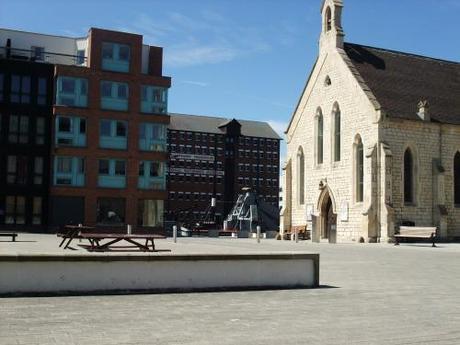
Gloucester Docks - another wasteland of hard landscaping
I recently read an article in the RHS magazine The Garden about the importance of urban greening of gardens on the environment and it aggravated a kind of sore that I experience when I drive through my neighbourhood.
I live on a small suburban housing estate which is made up of bungalows, detached and semi-detached houses. The estate is on a fairly steep hillside which means many people’s gardens slope. As well as this in the typical approach to housing in the UK, even back in the 1970s, the houses are shoe-horned in which means the gardens are tiny. One of the things that really struck me the first time I drove through the estate was the lack of trees. There are quite a few small trees, many of them heavily pruned but apart from overgrown leylandii hedges(and many of these are coming out) there is little to provide height. I love big skies and open spaces but not in a residential area. There is little to soften the hardness of the brick houses. I suppose people are worried about planting trees too close to houses but surely property developers should be made to incorporate trees into their plans – it is so important for urban greening, water runoff control and wildlife.
Being a housing estate there are restrictions on what you can and can’t do. You aren’t meant to have caravans or camper-vans parked on your property, bonfires or fences in the front garden. This latter rule and the initial layout by the property developers means that all the houses have open plan front gardens. Although for some unknown reason this isn’t the case in my small cul-de-sac of six houses where half of us have hedges – we are probably not very sociable!
The front gardens seem to consist of driveways, many quite steep, and open expanses of grass. There are some gardens of obviously keen gardeners where there are shrubs and perennials but they are in the minority. However, what is annoying me is the increasing move towards digging up front gardens and covering them with gravel. This isn’t, as in many cities and large towns, to provide additional parking this is so they don’t have to maintain a green space which as far as I am concerned is worse.
Many of the properties where this is happening are the bungalows where the older residents live and I suppose the argument is that this is easy maintenance. However, many have paid for landscape contractors to come in and terrace the sloping front gardens with railway sleepers and then top off with gravel – often different types/colours on each level! I am sure this hasn’t come cheap but is this really the best choice?
Opposite us is a bungalow with elderly residents. However, they have a beautifully maintained garden. Their answer is for my eldest son to cut their grass as and when needed whilst the lady of the house, despite her age is a whizz with the hedge trimmer. You might argue that a regular maintenance contractor can be expensive but I know many garden contractors don’t charge huge amounts and surely it would take a lot of grass cutting before they spent as much as those who have had the gravel treatment.
Of course, the gravel treatment isn’t a no maintenance answer. It is a haven for weeds to germinate in and I’m not surprised to see one of these gravelled areas a year on with lots of weeds sprouting. As for the local cats I am sure many are rubbing their paws together at the extended cat litter areas!
I don’t understand this approach. I don’t understand how people can prefer aggregates to horticulture. Surely they can’t prefer the glare and heat that comes off this sort of hard landscaping to the softness of grass and the color you get from shrubs and perennials not forgetting trees. I appreciate that gravel is better than other hard landscaping when it comes to water runoff and I was pleased to learn from the article in The Garden that planning permission is now needed for hard non-permeable landscaping but only for areas bigger than five square metres. I still think that the approach to housing in this country is to blame for a lot of the flooding we have experienced in recent years, there is just too much hard landscaping.
The article talks about the importance of urban gardens and how they provide environments for wildlife displaced due to man’s never-ending need for more space. I totally agree but I live in a suburban area with a beautiful large common on one side, a large golf course on the other and magnificent hills as a backdrop it should be a wonderful green area. However, it sometimes seems to me that some parts of my housing estate must be like a desert to wildlife.
It is so sad that people don’t realize that they can have a low maintenance garden that is attractive to both humans and wildlife. If they want to have gravel rather than worry about cutting grass then surely they could incorporate some planting into the design. Especially when the report I was reading talks about how clever planting around a house can help to keep it cool in the summer and insulate it in the winter. Maybe some wise landscapers will catch on to this idea and advise clients of the benefits and cost-savings they can make with the judicial use of plants. I really hope so as at this rate I will start to think I live in Dungeness.
I wanted to include a phot at the top of this post so choose to include a photo of Gloucester Docks an excellent example of urban ungreening.

